
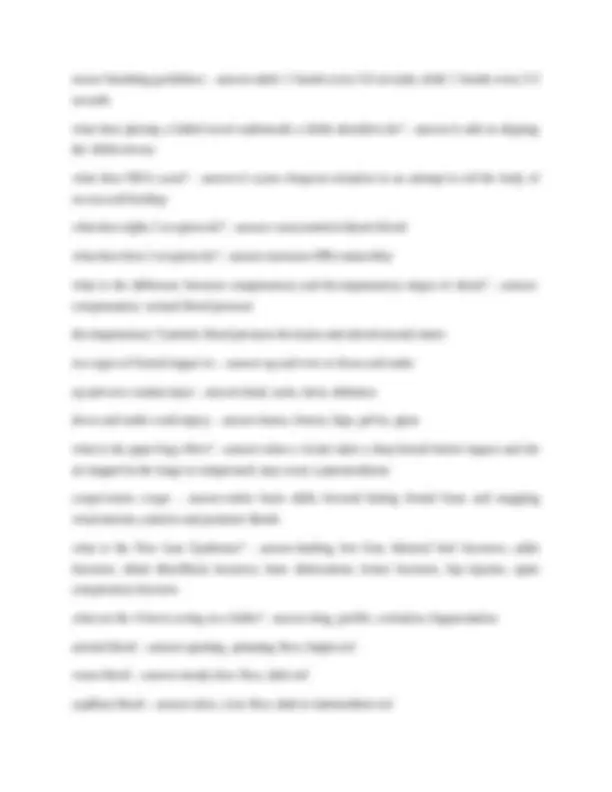
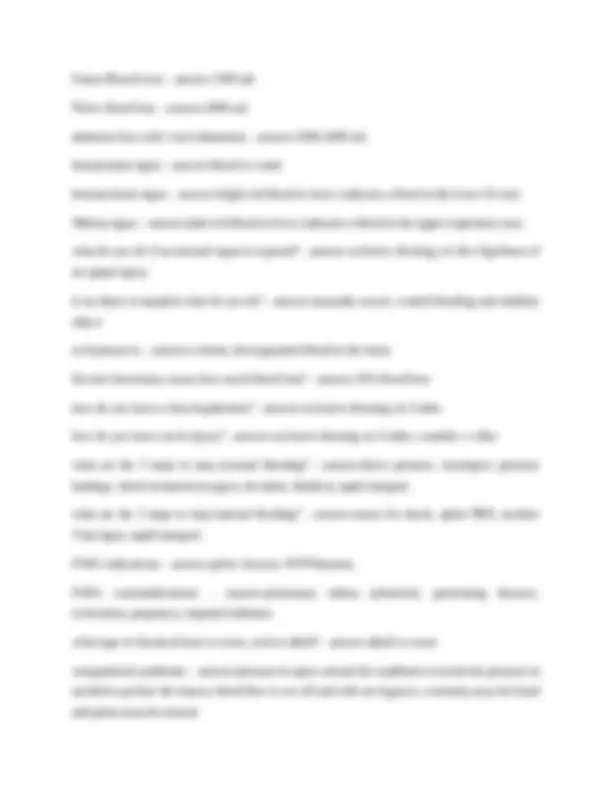
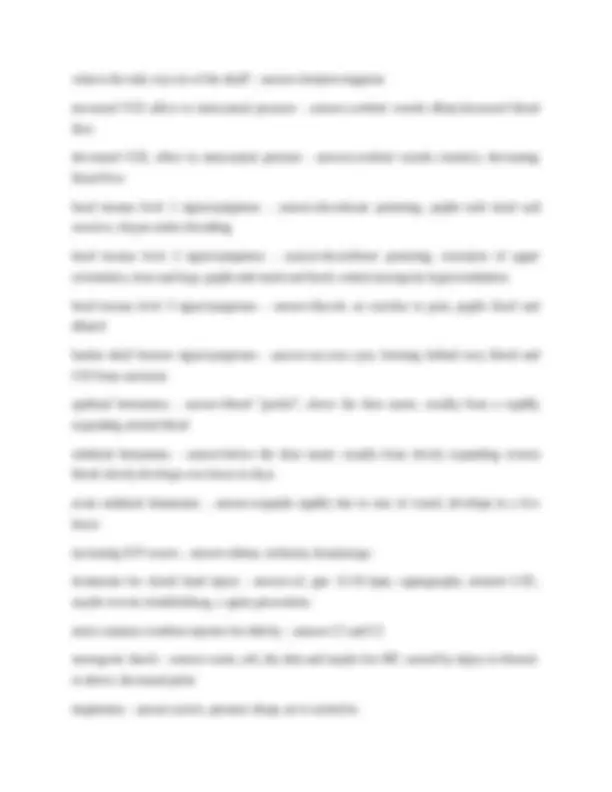

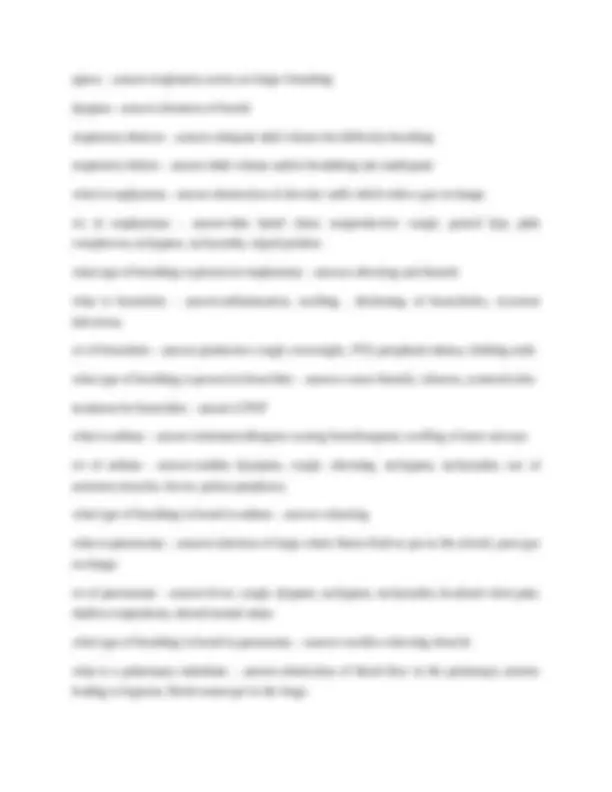
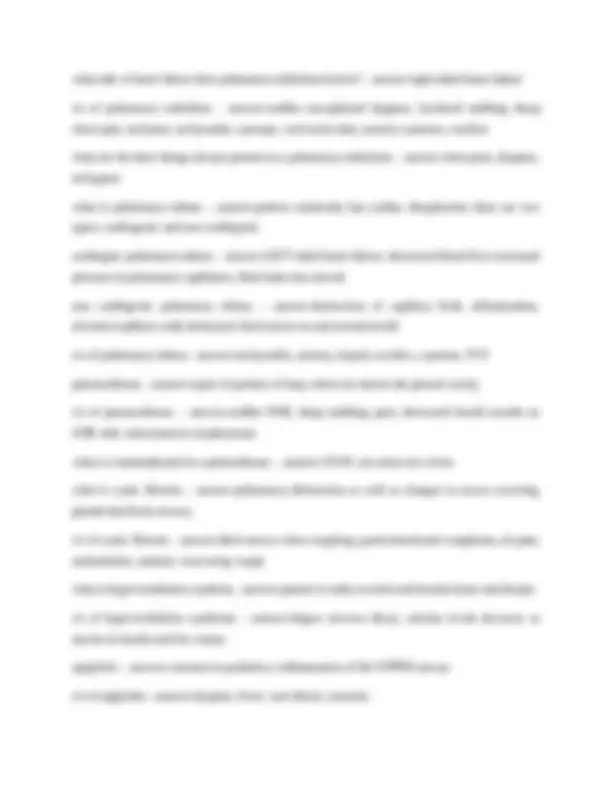
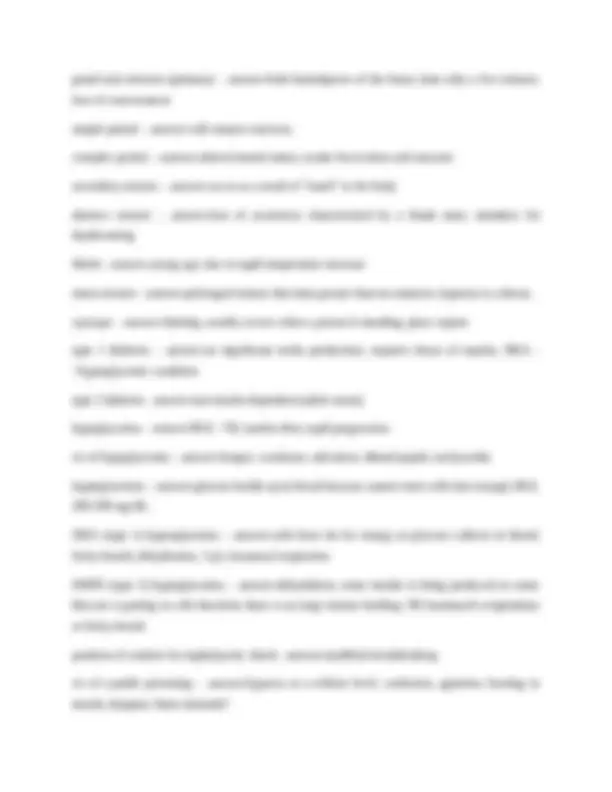
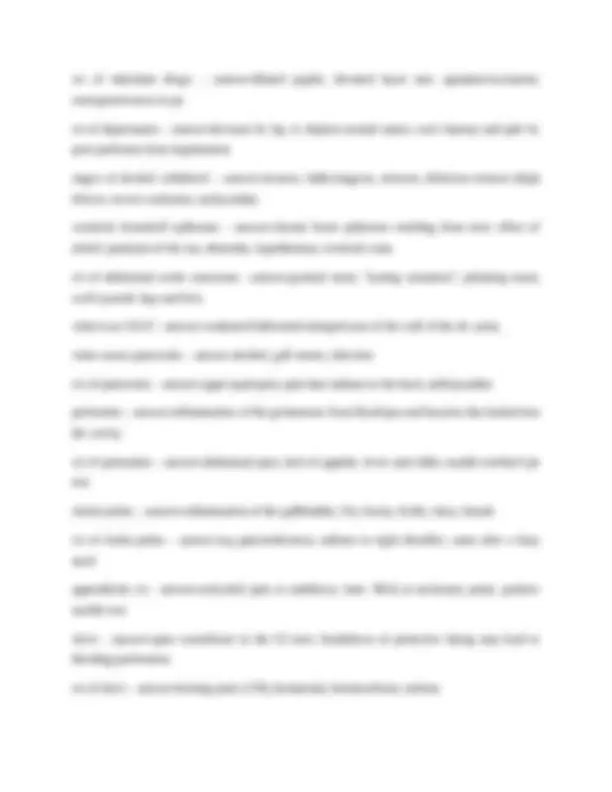
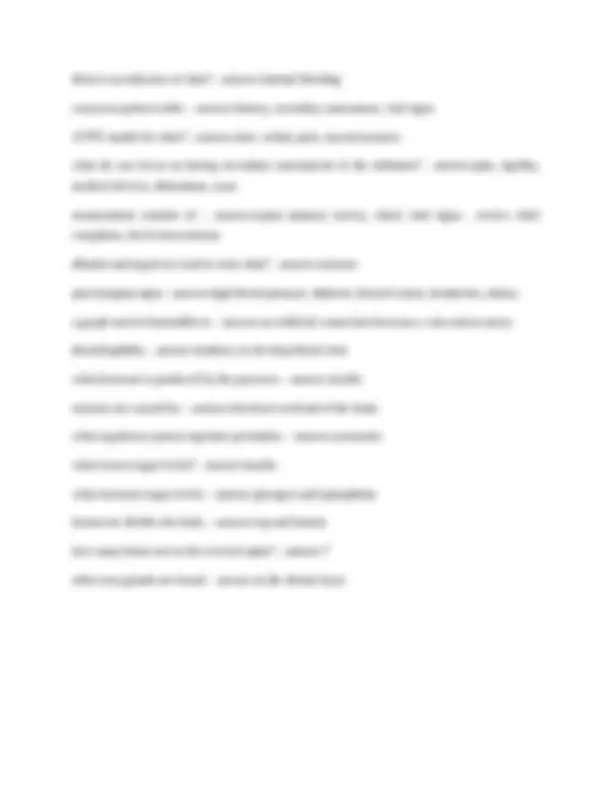


Study with the several resources on Docsity

Earn points by helping other students or get them with a premium plan


Prepare for your exams
Study with the several resources on Docsity

Earn points to download
Earn points by helping other students or get them with a premium plan
Community
Ask the community for help and clear up your study doubts
Discover the best universities in your country according to Docsity users
Free resources
Download our free guides on studying techniques, anxiety management strategies, and thesis advice from Docsity tutors
Detailed information on various emergency medical interventions and conditions, including the use of vasodilators, oral glucose, epinephrine, and albuterol, as well as the symptoms and management of conditions like myocardial ischemia, acute coronary syndromes, heart attacks, angina pectoris, congestive heart failure, strokes, seizures, and diabetes. It covers the indications, contraindications, actions, and side effects of these interventions, as well as the signs and symptoms of the discussed medical conditions. The document also touches on topics like thoracic aortic aneurysm/dissection, reperfusion, vascular headaches, and alcohol withdrawal. This comprehensive information can be valuable for healthcare professionals, students, and individuals interested in emergency medical care and the management of various cardiovascular, neurological, and metabolic conditions.
Typology: Exams
1 / 15

This page cannot be seen from the preview
Don't miss anything!










What is the rate of CPR in breaths and compressions: - answer-6 breaths and 110 compressions in a minute What is considered tachycardic for an adult? - answer-heart rate more than 100 What is considered bradycardic for an adult? - answer-Heart rate less than 60 When is nitroglycerin not advised to be administered? - answer-if the systolic blood pressure is less than 100 Where does blood flow after it leaves the left ventricle? - answer-it flows to the aortic arch What medication is Erectile Dysfunction medications a contraindication? - answer-nitroglycerin What is the parasympathetic system responsible for? - answer-slowing the heart rate and intestinal activity What is the function of the carotid artery? - answer-it carries blood from the heart to the head Are open ended or close ended questions better to ask? - answer-open ended questions; it avoids the yes/no answer what delivers blood to the right atrium? - answer-the superior and inferior vena cava What does diastolic blood pressure refer to? - answer-it refers to the pressure of the vessels during the relaxation phase; bottom of the blood pressure What is TIA - answer-transient ischemic attack; this is where vessels in the brain are blocked for a few minutes When do you change roles during CPR? - answer-every two minutes What is another name for a heart attack? - answer-acute myocardial infarction
What does nitroglycerin do? - answer-nitroglycerin dilates the vessels to reduce the hearts preload When cells are deprived of oxygen and die they are called? - answer-infarcted cells What type of heart attack is extremely common in elderly? - answer-silent heart attack What is arteriosclerosis? - answer-thickening of arterial walls What is pericardial tamponade? - answer-the heart is impeded by fluid in the pericardium What happens when someone has a pericardial tamponade? - answer-low blood pressure; muffled heart sound; weak pulse due to the hearts struggles to pump If a patient is unresponsive with a pulse you: - answer-2 quick rescue breaths then breaths 10- every minute what does a sphygmonometer measure? - answer-it measures blood pressure what is a normal systolic blood pressure for a child? - answer-80- what are three things to check if suspicious of a stroke? - answer-speech, facial droop, arm drift what are the actions of nitroglycerin - answer-smooth muscle relaxation, reduces cardiac workload, dilates coronary arteries, and dilates systemic arteries what happens if a patient has preeclampsia? - answer-hypertensive; extremely high blood pressure and swelling in extremeties; susceptible to seizures what is an ischemic stroke? - answer-blood flow being cut off from part of the brain what is the normal heart rate for a child - answer-70-110 beats per minute what ratio should 2 person cpr on a child be done at? - answer-15: what is the correct treatment for someone undergoing aphyxial cardiac arrest? - answer-5 cycles of CPR prior to retrieving the AED or emergency response system what is the most common reason for cardiac arrest in children? - answer-respiratory arrest what does the term lumen refer to in EMS? - answer-the diameter of a tube
Femur Blood Loss: - answer-1500 mL Pelvic blood loss: - answer-2000 mL abdomen loss with 1 inch distention: - answer-1000-2000 mL hematemisis signs: - answer-blood in vomit hematochezia signs: - answer-bright red blood in feces; indicates a bleed in the lower GI tract Melena signs: - answer-dark red blood in feces; indicates a bleed in the upper respiratory tract what do you do if an internal organ is exposed? - answer-occlusive dressing x4; flex hips/knees if no spinal injury if an object is impaled what do you do? - answer-manually secure; control bleeding and stabilize object ecchymosis is: - answer-a bruise; deoxygenated blood in the tissue fist size hemotoma causes how much blood loss? - answer-10% blood loss how do you treat a chest impalement? - answer-occlusive dressing on 3 sides how do you treat a neck injury? - answer-occlusive dressing on 4 sides; consider c collar what are the 5 steps to stop external bleeding? - answer-direct pressure, tourniquet, pressure bandage, shock treatment (oxygen, elevation, blanket), rapid transport what are the 5 steps to stop internal bleeding? - answer-assess for shock, splint PRN, monitor Vital signs, rapid transport PASG indications: - answer-pelvic fracture, HYPOtension, PASG contraindications: - answer-pulmonary edema (absolute); penetrating thoracic, eviseration, pregnancy, impaled abdomen what type of chemical burn is worse, acid or alkali? - answer-alkali is worse compartment syndrome: - answer-pressure in space around the capillaries exceeds the pressure in needed to perfuse the tissues; blood flow is cut off and cells are hypoxic; extremity may feel hard and pulses may be normal
what is the only way out of the skull? - answer-foramen magnum increased CO2 affect in intracranial pressure - answer-cerebral vessels dilate;Increased blood flow decreased CO2, effect in intracranial pressure - answer-cerebral vessels constrict; decreasing blood flow head trauma level 1 signs/symptoms: - answer-decorticate posturing; pupils mid sized and reactive; cheyne-stokes breathing head trauma level 2 signs/symptoms: - answer-decerebrate posturing; extension of upper extremities; torso and legs; pupils mid sized and fixed; central neurogenic hyperventilation head trauma level 3 signs/symptoms: - answer-flaccid, no reaction to pain, pupils fixed and dilated basilar skull fracture signs/symptoms: - answer-raccoon eyes; bruising behind ears; blood and CSF from ears/nose epidural hematoma: - answer-blood "pocket"; above the dura mater, usually from a rapidly expanding arterial bleed subdural hematoma: - answer-below the dura mater; usually from slowly expanding venous bleed; slowly develops over hours to days acute subdural hematoma: - answer-expands rapidly due to size of vessel; develops in a few hours increasing ICP causes: - answer-edema, ischemia, hemmorage treatments for closed head injury - answer-o2, ppv 12-16 bpm; capnography, monitor LOC, maybe reverse trendelenburg, c-spine precautions most common vertebrae injuries for elderly: - answer-C1 and C neurogenic shock: - answer-warm, red, dry skin and maybe low BP; caused by injury to thoracic or above; decreased pulse inspiration: - answer-active; pressure drops, air is sucked in
pediatric assessment triangle: - answer-appearance: overall mental status; work of breathing: circulation to skin differences in geriatric patient: - answer-BP drops sooner; decreased cough reflex; hypertensive patients may have normal BP during shock the five "rights" - answer-right patient, right medication, right dose, right time, right route of administration inidactions of Asprin: - answer-patient having chest pain; may keep vessels that deliver blood to the heart from completely shutting off; suggestive of a heart attack contraindications of aspirin: - answer-allergy; patient with bleeding ulcers/internal bleeding dosage of aspirin: - answer-162-324 mg; 81 mg each baby aspriin dosage of nitroglycerin: - answer-0.4 mg indication of nitroglycerin - answer-cardiac chest pain what does nitroglycerin do? - answer-vasodilator; drops your preload to help the heart pump; reduces workload; drops blood pressure conditions that must be met before administering nitroglycerin: - answer-minimum systolic of 9ommhg; heart rate should be between 50-100; max of 3 contraindications of nitroglycerin - answer-systolic lower than 90; cannot take with erectile dysfunciton medications; allergy indications for oral glucose: - answer-altered mental status; diabetes history; ability to swallow contraindications for oral glucose: - answer-unconcsious; inability to swallow action of oral glucose: - answer-increases blood sugar and brain sugar levels side effects of oral glucose: - answer-airway obstruciton actions of epinephrine: - answer-mimics response of sympathetic nervous system; constricts blood vessels to improve blood pressure; relaxes smooth muscles to improve breathing; stimulates heartbeat; reverses swelling and hives
side effects of epinephrine: - answer-increased heart rate, pale skin, dizziness, chest pain, headache, nausea, vommiting, anxiousness, excitiability indications for epinephrine: - answer-hypertension; alterned mentation, breathing problems indications for albuterol: - answer-s/s of dyspnea with bronchoconstriction, wheezing contraindications of albuterol: - answer-not responsive enough to use; precautuions when chest pain; hr> dosage of albuterol in neb form: - answer-2.5 mg/ml indications for activated charcoal: - answer-poison ingested by mouth within two hours time contraindications for activated charcoal: - answer-altered mental status; swallowed acids or alkalis wheezing: - answer-high pitched whistling; constriction of bronchioles; LOWER airway; treat with albuterol common conditions where wheezing is present: - answer-asthma, emphysema, chronic bronchitis, COPD rhonchi: - answer-snoring/rattling; thick mucuous secretion; sound changes when cough and move common conditions where rhonchi is present: - answer-pneumonia; aspiration; chronic bronchitis, emphysema crackles/rales: - answer-bubbly osund during inhalation; fluid surrounding or filling the bronchioles/alveoli; base of lungs exhibit first common conditions where crackles/rales are present: - answer-pulmonary edema, pneumonia, CHF treatment for crackles rales: - answer-ppv/bvm/cpap hypoxia vs hypoxemia: - answer-hypoxia is decreaesd oxygen in tissues/cells; hypoxemia: decreased oxygne in blood stream
what side of heart failure does pulmonary embolism lead to? - answer-right sided heart failure s/s of pulmonary embolism: - answer-sudden unexplained dyspnea; localized stabbing sharp chest pain; tachynea; tachycardia; syncope; cool moist skin; anxiety cyanosis; crackles what are the three things always present in a pulmonary embolism: - answer-chest pain, dyspnea, tachypnea what is pulmonary edema: - answer-patient commonly has cardiac disypfuction there are two types; cardiogenic and non cardiogenic cardiognic pulmonary edema: - answer-LEFT sided heart failure; decreased blood flow increased pressure in pulmonary capillaries; fluid leaks into alveoli non cardiogenic pulmonary edema: - answer-destruction of capillary beds; inflammation, alveolar/capillary walls destroyed; fluid moves in and around alvelli s/s of pulmonary edema - answer-tachycardia; anxiety; tripod; crackles, cyanosis, JVD pneumothorax - answer-rupter of protion of lung where air enteres the pleural cavity; s/s of pneumothorax: - answer-sudden SOB; sharp stabbing pain; decreased breath sounds on ONE side; subcutaneous empheysema what is contraindicated in a pnemothorax: - answer-CPAP; you must use a bvm what is cystic fibrosis: - answer-pulmonary disfunction as well as changes in mucus secreting glands that block airway; s/s of cystic fibrosis: - answer-thick mucus when coughing; gastrointestional complaints; ab pain; malnutrition; malaise; reoccuring cough what is hyperventilation syndrom - answer-patient is really excited and breaths faster and deeper s/s of hyperventilation syndrome - answer-fatigue nervous dizzy; calcium levels decrease so mucles in hands and feet cramp epiglottis: - answer-common in pediatrics; inflammation of the UPPER airway s/s of epiglottis - answer-dyspnea; fever; sore throat; cyanosis
what type fo breathing is found in epiglottis: - answer-stridor what is whooping cough: - answer-UPPER airway infection; highly contagious; starts as cold can progress to pneumonia respiratory distress in pedis: - answer-retractions are an early sign; grunting; see-saw breathing, increased accessory muscle use respiratory failure in pedis: - answer-head bobbing, see saw breathing; core cyanosis; loss of muscle tone; bradycardia; absent breath sounds; hypotention what is the postion of comfort for respiratory emergencys? - answer-flowlers kussmaul sign: - answer-JDV during inhalation and returns to normal during exhalation; indicates severely increased pressure in chest or around the heart myocardial ischemia: - answer-insufficient fuels getting to heart cells; causes irritation ischemic chest pain - answer-constant; not changing with movement or palpation; indication of myociaridal ischemia; causes referred pain bc heart has no sensory nerves atherosclerosis: - answer-buildup of fat and cholesterol; s/s of acute coronary syndromes: - answer-crushing, pressure, squeezing, radiate ot arm, shoulder back; constant; pale cool skin; nausea, dizziness, synocpe; abnormla heart beats; shortness of breath s/s of a heart attack: - answer-radiating chest discomfort; anxiety; dyspnea; sense of impending doom; diaphresis; vommiting; rapid and irregular pulse; JDV; edema what is a silent MI - answer-heart attack; common in women, elderly, diabetics; no chest pain; but yes shortnes of breath, nasuea, lightheadedness and weakness angia pectoris: - answer-temporary interruption of fuel; "chest pain" s/s of angia pectoris: - answer-cardiac chest pain; radiating; cool clammy anxiety, diaphroesis; treat with nitro thoracic aortic aneurysm/dissection: - answer-aneuryms: occurs when weakened section of aortic wall begins to dilate; pulsating mass
grand mal seizures (primary): - answer-both hemishperes of the brain; lasts only a few minues; loss of conciousness simple partial: - answer-will remain concious; complex partial: - answer-altered mental status; awake but in daze and unaware secondary seizure: - answer-occur as a result of "insult" to the body absence seizure: - answer-loss of awareness characterized by a blank stare; mistaken for daydreaming fibrile - answer-young age; due to rapid temperature increase status seizure - answer-prolonged seizure that lasts greater than ten minutes; hypoxia is a threat; syncope: - answer-fainting; usually occurs when a person is standing; place supine type 1 diabetes: - answer-no significant isulin production; requires doses of insulin; DKA -
hyperglycemic condition type 2 diabetes - answer-non insulin dependent (adult onset); hypoglycemia: - answer-BGL <50; insulin shot; rapid progression s/s of hypoglycemia: - answer-hunger, weakness, salivation, dilated pupils; tachycardia hyperglycemia: - answer-glocose builds up in blood because cannot enter cells fast enough; BGL 200-500 mg/dL; DKA (type 1) hyperglycemia: - answer-cells burn fat for energy as glucose collects in blood; fruity breath; dehydration; 3 p's; kussmaul respiration HHNS (type 2) hyperglycemia: - answer-dehyrdation; some insulin is being produced so some blucose is getting to cells therefore there is no large ketone buildup; NO kussmaul's respirations or fruity breath position of comfort for anphylyactic shock - answer-modified trendelenburg s/s of cyanide poisoning: - answer-hypoxia at a cellular level; confusion; agitation; burning in mouth; dyspnea; bitter almonds?
s/s of stimulant drugs: - answer-dilated pupils; elevated heart rate; agitation/excitation; unresponsiveness to pn s/s of depressants: - answer-decrease hr, bp, rr; depress mental status; cool clammy and pale bc poor perfusion from hypotension stages of alcohol withdrawl: - answer-tremors; hallucinagens; seizures; delerium tremors (high felever, severe confusion, tachycardia) wernicke korsakoff sydnrome: - answer-chronic brain sydnrome resulting from toxic effect of alchol ;paralysis of the eys, dementia, hypothermia; eventual coma s/s of abdominal aortic aneurysm - answer-gradual onset; "tearing sensation"; pulsating mass; cool/cyanotic legs and feet; what is an AAA? - answer-weakened ballooned enlarged area of the wall of the ab. aorta; what causes pancreatis: - answer-alcohol, gall stones, infection s/s of pancreatis: - answer-upper quad pain; pain that radiates to the back; mild jaundice peritonitis: - answer-inflammation of the peritoneum from blood/pus and bacteria that leaked into the cavity; s/s of peritonitis: - answer-abdominal pain; lack of appitite, fever and chills; markle test/heel jar test cholecystitis: - answer-inflammation of the gallbladder; Fat, fourty, fertile, farty, female s/s of cholecystitis: - answer-ruq pain/tenderness; radiates to right shoulder; onset after a fatty meel appendicitis s/s - answer-early:dull pain at umbilicus; later: RLQ at mcburney point; positive markle test ulcer: - answer-open wound/sore in the GI tract; breakdown of protective lining may lead to bleeding/perforation s/s of ulcer: - answer-burning pain; LUQ; hematemis; hematochezia; melena